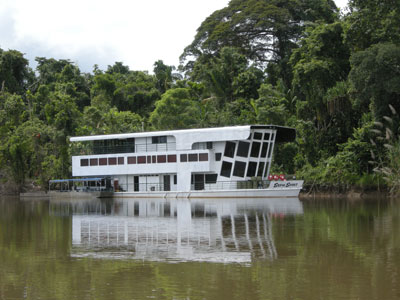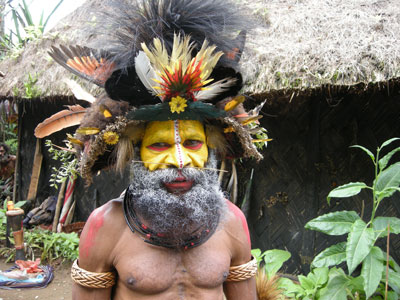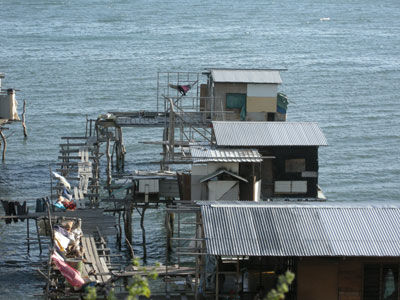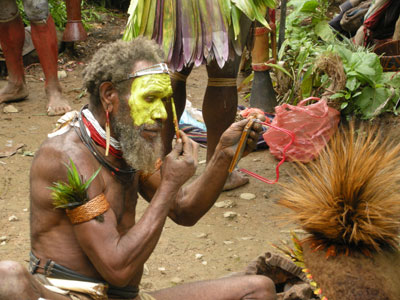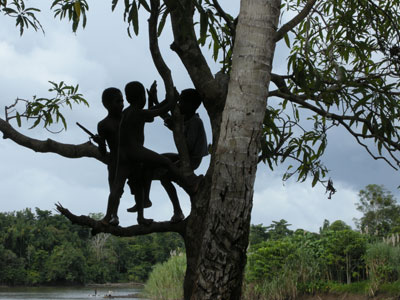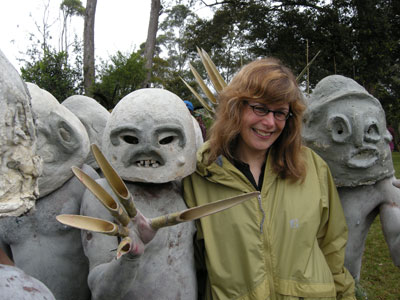Papua New Guinea — Spirits, sing sings and the woman thing
by Clark Scott, Birmingham, AL
From everything I’d heard, read or seen about Papua New Guinea, it was death itself to go to that little-visited island off the northeast coast of Australia. A recent Internet story included the capital, Port Moresby, on its Top 10 Hells on Earth list, and everyone said the country was crawling with venomous snakes, disease, rampant “raskols” (the PNG term for robbers, murderers and rapists) and tribal wars — just the kind of place your grandmother told you never to go.
Payback
I wasn’t worried about the danger, really, despite the stories. Of course, there was the guide who picked us up at the Port Moresby airport, his face bruised and his lip cut, hugely puffed up and badly stitched, with black threads hanging down his chin.
Our guide assured us his injuries were merely accidental. He had been blindsided by a beer bottle the night before — a wild swing by the jealous uncle of a girl he had been chatting up at his local bar. He said his friends had beaten up the uncle afterward, so everything evened out.
PNG is all about payback, I would learn. Compensation makes its world go ’round.
“5 Killed Over Pig”: that was the headline I recalled while our guide told his bar-fight story. It was from a Reuters article noting that five people were killed and dozens injured at a peace ceremony when a fight broke out between two tribes over the best way to serve a pig. The fight escalated into a 5-day war involving over 2,000 Highland tribesmen.
So why go to a country like that? My wife, Josie, and I went for different reasons.
I went because a Paris dealer in PNG artifacts had told me great stories about an idiosyncratic people who carved beautiful art inspired by their belief in spirits and who practiced strange customs, drank and gambled a lot and told wonderful lies. To me, it sounded like the most twisted place on Earth.
Josie wanted to visit the country’s middle-of-nowhere rivers and mountains and get a firsthand look at the relationship between the sexes there (famously studied by Margaret Meade).
To play it extra safe, we traveled with someone experienced in PNG’s ways, Greg Stathakis, a retired Santa Barbara schoolteacher who has been taking small groups of visitors and large bags of welcome first-world staples — everything from T-shirts and candy to school supplies — to PNG every year for the last 30 years.
Don’t knock Port Moresby
We began our May ’08 tour by hitting the highlights of Port Moresby, including the Parliament House and the botanical gardens plus the National Museum, which surprised us with its beautifully carved masks, totems, headdresses, drums, canoes and antiquities from all over the country. It was dimly lit, almost too dark to see. Apparently, the cost of electricity was more than the museum could bear.
Visiting the local fishing villages outside the capital, we got our first up-close look at the way things are in PNG. The houses were pieced together from scrap metal and perched on stilts in the water, offering an open window on the inhabitants’ lives, with people sleeping and eating and bathing on the narrow palm planks that served as their porches. The modern skyscrapers of Port Moresby in the distance created an odd contrast.
We learned some Tok Pisin (pidgin English), the most widely spoken language in this country with over 800 indigenous languages. The “Do Not Disturb” sign on our hotel door read “Yu No Ken Kam Insait.”
We were warned not to go downtown alone and to never wander outside our walled and guarded hotel compound at night. But the only mildly threatening encounter we had was with a security guard on the hotel grounds.
He asked us where we were from, then began to tell us about himself, punctuating the story of his life with frequent, wild hand gestures. He said he came from a village in the Highlands and that he was very poor. He said he’d like to tell us more about himself and asked for our room number so he could come by that night to talk after he got off work at midnight.
Another hotel guest came along just then and we bolted. Fortunately, there was no knock at our door at midnight.
Magical spirits along the Sepik
We left Port Moresby the next day and flew inland on a tiny, chartered plane to the remote Sepik River region. We spent several days there, making slow time on the Sepik Spirit, a 9-cabin houseboat, visiting palm-enveloped villages by motor launch along the way.
The winding, Eden-like Sepik, Karawari and Cros Meri rivers are set in a jungle near nowhere. The mostly naked villagers don’t get many Western visitors, but they create much of the art for which PNG is famous.
Our Sepik days were a stunning visual experience, filled with art finds and pleasant exchanges with the villagers. We especially enjoyed the children, who followed us about, giggling among themselves. They were shy at first, then delighted when we asked them their names and shook their hands.
The only sign of danger was the “blood stone” we saw in front of a spirit house. A long time ago, we were told, the villagers used it as a hard surface on which to ritualistically lop off their enemies’ heads.
The most interesting sights were the spirit houses themselves. Not only were they remarkable architectural works, they held each village’s closely guarded secrets — the important carvings and other artistic representations of the magical spirits and ancestors that many in PNG still believe influence every aspect of their lives.
No one dies of old age, disease or bad luck in PNG. Someone in a neighboring village cast a spell or some evil spirit did it. And, for that, there must be compensation, so there are lots of tribal wars.
Huli Wigmen
Noting the tininess of our tiny plane, we flew to Tari in the Southern Highlands, the home of PNG’s fiercest warriors, the Huli Wigmen.
The Huli Wigmen are all about bone and bamboo nose piercings, face paint and big hair wigs shaped like mushroom caps and festooned with the feathers of birds of paradise, cassowary and other birds intertwined with woven grasses, twigs and flowers. They love to dress up in their finery for any occasion, but they adorn themselves fantastically for every day.
We were told that the men have an innate fear of women, whom they blame for stealing their power to give birth. They believe too much contact with women, even their wives, could reduce their powers further, so they live in huts with other men.
The men take care of wars and manage the interaction with spirits. The women do all the work. They grow the yams that are the Hulis’ primary diet and raise the children and the pigs.
We stayed at the Ambua Lodge, a compound of thatch-roofed guest cottages set high in the lush, green mountains. Everything natural was outsized, from the spiderwebs large and thick enough to trap birds to the tree-size ferns and bright, blooming flowers as big as dinner plates. Unlike Port Moresby, there wasn’t a hint of danger there, at least not since the robbery five days before.
A bartender had been fired by the lodge, and he came back with his clan packing shotguns to demand compensation. The police wouldn’t answer the call. They were from another tribe, and if any of the Hulis were injured the police would have had to pay. The lodge’s security guards backed off for the same reason.
Because long negotiations and pontifications are a part of the culture, the lodge’s management and the disgruntled bartender haggled for 10 to 12 hours before they finally agreed on how much he would steal. He didn’t touch any of the tip envelopes in the safe addressed to other employees, because they would have come after him for payback.
The guests were never in danger, we were told. It was just between the bartender and the lodge.
Violence and compensation also enter into domestic relations. One of the lodge’s employees, Alice, told us she had divorced her husband because she was tired of his beatings. As a result, her family had to repay his family the bride price of 40 pigs plus interest — a hefty sum, arrived at after tortuous negotiation. Over time, she would have to repay her family out of her wages.
Alice was an educated woman with one foot in tradition, trying to gain a step on a better future. She was impressive all around and it had cost her a lot.
Tumbuna Sing Sing
Our last stop in PNG was Mount Hagen for the Tumbuna Sing Sing. It was to be the grand finale of our visit, that dazzling burst of fireworks at the end of the PNG “show.”
A sing sing is a big gathering at which a dozen or more tribes decked out in all their glory advance on each other and the audience, singing and dancing and waving their weapons. Every tribe has its own signature look and its own special moves.
One tribe might be painted black and white from head to toe to look like skeletons doing the walking-dead-man jangle, while another, their faces painted red, their eyes and lips outlined in vibrant white and wearing brightly feathered headdresses, jumps up and down as if trying to reach the sky.
My favorites were the mudmen, whose big, mud-sculpted heads — covering their real heads — perched on their shoulders like monochromatic jack-o’-lanterns. Their whole bodies were caked in matching gray mud and they stalked rather than danced, striking ominous poses while they clicked their long, sharp, bamboo-sheathed fingers threateningly at whoever caught their eye.
The major festivals are held several times a year and are attended by anywhere from a few to a few hundred tourists and many times that number of PNG nationals. At this particular sing sing, after their initial explosion of singing and dancing, the tribal participants alternated between mugging for the tourists’ cameras and becoming lost in the motion of their own music again.
As the day wore on, there was less mugging and more communal dancing and singing, with huge circles forming, men and women all together with their arms around each other’s shoulders, jumping up and down, going ’round and ’round.
For me, from the first moment the tribes rushed onto the field in a huge swell of clashing colors and sound and movement, it was sensory overload. I didn’t know quite what to make of it. You could say the same about Papua New Guinea.
The hardest thing about PNG isn’t the potential for danger; it’s that it’s so full of contradictions, you’re never sure you really get it.
But see for yourself. It won’t kill you.
The details
Greg Stathakis knows which way to look crossing the street in Papua New Guinea. He made sure we dodged danger and gave us the inside scoop every step of the way.
You can contact Greg by calling 800/676-1241 or visiting www.pngtravel.com. The cost of our trip was $7,450 per person, not including international airfare.


